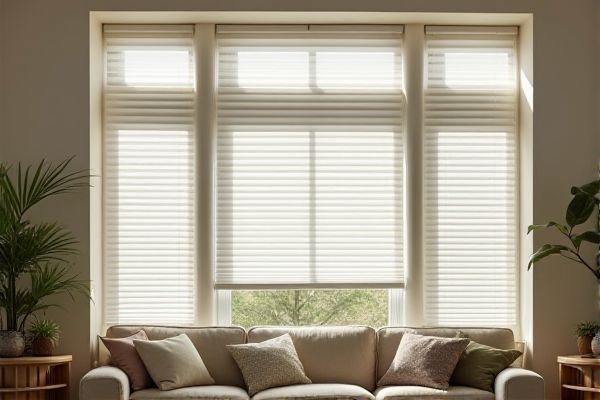
Light-filtering shades gently diffuse sunlight to create a soft, natural glow in your room while maintaining some visibility and privacy, making them ideal for spaces where you want to reduce glare without complete darkness. Blackout shades block nearly all light, providing maximum privacy and darkness, perfect for bedrooms or media rooms where full shade is essential; discover which option best fits your needs by reading the rest of the article.
Table of Comparison
| Feature | Light-Filtering Shades | Blackout Shades |
|---|---|---|
| Light Control | Soft, diffused natural light | Complete darkness |
| Privacy | Moderate privacy during the day | High privacy any time |
| Material | Lightweight, translucent fabrics | Opaque, heavy fabrics or layered |
| Energy Efficiency | Moderate insulation value | Superior insulation and UV blocking |
| Ideal Usage | Living rooms, kitchens, offices | Bedrooms, media rooms, nurseries |
| Cost | Generally lower cost | Usually higher cost |
| Maintenance | Easy to clean and maintain | Requires regular cleaning due to heavier fabric |
Introduction to Window Shades: Light-Filtering vs Blackout
Light-filtering shades allow natural light to enter while reducing glare and providing privacy, making them ideal for living rooms and kitchens. Blackout shades block nearly all incoming light, perfect for bedrooms or media rooms where darkness is essential for sleep or screen visibility. Both types offer energy efficiency and UV protection, but the choice depends on the desired level of light control and room function.
Defining Light-Filtering Shades
Light-filtering shades are designed to softly diffuse natural light, reducing glare while maintaining a comfortable brightness in your room. Unlike blackout shades, they do not block out light completely but create a gentle ambiance that protects furniture from UV damage. These shades are ideal for spaces where you want privacy without sacrificing natural daylight.
Defining Blackout Shades
Blackout shades are designed with thick, opaque materials that block nearly 100% of light, providing complete darkness ideal for bedrooms or media rooms. These shades offer superior insulation and privacy by preventing any light from penetrating through the fabric or gaps. You benefit from enhanced comfort and energy efficiency when choosing blackout shades over light-filtering options.
Key Differences Between Light-Filtering and Blackout Shades
Light-filtering shades allow natural light to diffuse softly into a room while reducing glare, making them ideal for living spaces and offices where balanced illumination is desired. Blackout shades block nearly all incoming light, providing complete darkness and enhanced privacy, which is perfect for bedrooms and media rooms. The primary differences lie in light control, privacy level, and energy efficiency, with blackout shades offering superior insulation and darkness compared to the more translucent and ambient light-friendly light-filtering options.
Light Control and Privacy Comparison
Light-filtering shades allow natural daylight to softly illuminate a room while reducing glare and offering moderate privacy by obscuring views from outside. Blackout shades block nearly 100% of incoming light, providing complete darkness ideal for bedrooms or media rooms, and ensure maximum privacy by preventing any visibility into the room. Choosing between these options depends on balancing desired light control with privacy needs, where blackout shades deliver superior privacy and light exclusion compared to the gentler filtering effect of light-filtering shades.
Energy Efficiency: Which Shade Performs Better?
Light-filtering shades allow natural light to pass while reducing glare and heat gain, resulting in moderate energy savings by lowering cooling costs during the day. Blackout shades provide superior insulation by completely blocking sunlight and preventing heat transfer, making them more effective at reducing both cooling and heating expenses year-round. Your choice depends on whether maximizing energy efficiency or maintaining natural light is the priority, with blackout shades performing better in overall energy conservation.
Ideal Rooms for Light-Filtering Shades
Light-filtering shades are ideal for living rooms, kitchens, and dining areas where you want to soften natural light while maintaining some level of privacy. These shades reduce glare and UV rays without completely darkening the space, making them perfect for rooms with abundant sunlight. Your choice of light-filtering shades enhances comfort and preserves views, creating a warm and inviting atmosphere.
Best Spaces for Blackout Shades
Blackout shades excel in bedrooms and media rooms where complete darkness enhances sleep quality and viewing experiences. They block nearly 100% of incoming light, creating an ideal environment free from glare and external distractions. These shades also improve energy efficiency by insulating windows against heat and cold, making them suitable for spaces requiring temperature control.
Style and Material Options for Both Shade Types
Light-filtering shades offer a broad variety of fabrics, including sheer, woven, and textured materials that softly diffuse natural light while enhancing room aesthetics with elegant, translucent designs. Blackout shades come in heavier, opaque fabrics such as vinyl, polyester blends, and thermal materials designed to completely block light and provide superior insulation and privacy. Both shade types are available in diverse styles, including roller, cellular, and Roman shades, allowing customization of texture, color, and pattern to suit different interior design preferences and functional needs.
Making the Right Choice: Factors to Consider
When making the right choice between light-filtering shades and blackout shades, consider the purpose of the room and your light control needs. Light-filtering shades provide a soft, diffused natural light ideal for living areas or kitchens, while blackout shades are perfect for bedrooms or media rooms requiring complete darkness and privacy. Your decision should factor in energy efficiency, UV protection, and how much light you want to block or allow for comfort and functionality.
 homyna.com
homyna.com